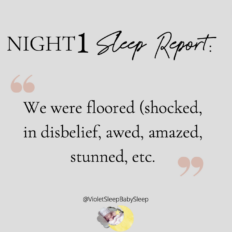
Toddler Sleep Regression? Here’s What to Do
One of the things I love best about the baby sleep training program I have developed is that the results can be fast. In fact, many little ones can be taught to sleep on their own in just a week. And I have loved hearing from clients that their little ones are sleeping beautifully!
So the first time a former client called me to say, “my toddler was sleeping great — now he’s getting up in the middle of the night again,” I knew something bigger was going on.
I also knew from my experience as a registered nurse and certified baby sleep consultant that where there is a problem, there is a solution.
So I began digging into the science, interviewing clients, and adding courses for my students. Here’s what I found out about toddler sleep regression, and what to do if it’s happening with your child.
What is Toddler Sleep Regression?
It’s important to know that night wakings don’t always mean a regression. Toddler sleep regression happens when a child who was previously sleeping well, suddenly has issues with sleeping.
Unfortunately, that’s what makes it so confusing for parents. Your child was sleeping beautifully. Now, suddenly, they’re up at 2AM, ready to play, eat or just cry. Or they may have other sleep disturbances that seem to come out of the blue.
Here are different types of sleep regression your toddler or preschooler may be experiencing.
Types of Toddler Sleep Regression
(And What to Do)
Type #1: Your Child Awakens During the Night
With this type of regression, a toddler who previously slept through the night without needing a parent or caregiver, begins crying for you at night.
This does not necessarily mean your toddler never wakes during the night. If they are able to self-soothe back to sleep (see my training course for details), this is not an actual sleep regression.
What to Do:
- Go to your child. Letting them cry it out could harm your child’s trust in you.
- See if your toddler will be soothed without taking them out of their crib. Try gentle pats and quiet talking.
- If you need to pick your child up, make sure you stay close to the crib. Do not leave the room. It isn’t playtime. Further, taking the child away from something they seem leery of will reinforce to them that there is danger. After all, Mommy is taking them away. So stay in the nursery.
- Keep the lights dim. It is sleepy time; darkness helps reinforce this.
- Put your toddler back down and let them try again to fall sleep on their own.
Type #2: Your Child Won’t Fall Asleep on Their Own
Some babies seem to learn to fall asleep on their own. Others need a little help.
Either way, if your child has been falling asleep on their own, but now they are suddenly fussy or wide-awake when you put them down, it could be a sign of a toddler sleep regression.
What to Do:
- Resist the urge to rock your child to sleep, then transfer them to the crib. A child who falls asleep in one place and awakens in another will be disoriented and frightened.
- Keep to your usual bedtime routine, or revamp your old one. Either way, make sure to reinforce “sameness,” night after night. Eventually your baby’s body and mind will “remember” how to begin getting sleepy.
- Follow the steps in Type #1 above.
Type #3: Your Child Sleeps More During the Day, Less at Night
This type of regression is roughly similar to the normal sleep habits of a newborn. Though the total hours are about equal, babies tend to nap several times a day and get up a couple of times at night.
Toddlers drop one or two naps and sleep longer at night.
If your child was in the stage of less napping, but now the daytime sleep is back and nighttime rest is out the window, this could be a regression.
What to Do:
- Take your child to the pediatrician. You should try this FIRST. A child who is sleeping more, whether during the day or at night, could be coming down with something, or there may be some other reason. Get a clean bill of health for your toddler before proceeding.
- Begin gently waking your child from their daytime naps. Move gradually. If your child was sleeping for 2 hours, and now it’s 3 hours, wake her at 2.5 hours. After a few days, wake her after 2.25 hours, and finally, at 2 hours.
- Expect your child to be a little cranky. They are trying to make up for lost sleep at night. Instead, help them get that rest when they should be getting it.
Type #4: Your Child Wants Their “Lovey” Back
I’m not against sleep associations. A favorite toy or blanket can be a huge help with infant sleep training.
Some children hold onto their “lovey” into toddlerhood or slightly later. That’s okay, too. But if they didn’t need their lovey, and are suddenly asking for it, your toddler may be going through a sleep regression.
What to Do:
- Make sure your little one isn’t coming down with a cold or other illness. It’s normal to want to be babied a bit when you’re sick — even we grownups feel this way!
- While it’s a personal choice, I recommend allowing your child their lovey for now. Meanwhile, check below to see if anything else might be disturbing your child’s sleep.
Other Things to Consider
- Any time a habit changes significantly, it’s a good idea to check in with the pediatrician. Once your child gets a clean bill of health, go ahead and try the options above.
- Has your child recently had a scare? Walking into the living room in the middle of the night while you’re watching a scary movie could be giving your little one nightmares. Or a recent run-in with a barking dog, a bigger, loud child, or anything that could be frightening, may set their sleep progress back temporarily.
- Resist the urge to say, “be a big girl” or “be a big boy.” Toddlers may rebel against this out of a sense of a need for control, or out of fears they can’t express to you.
- Your child may be experiencing separation anxiety. There are a number of ways to address this and get your little one sleeping again. Consulting with the experts can be a great way to find out what’s going on.
Little one not sleeping?
There IS a solution.
Contact me today!
Whatever the reason for toddler sleep regression, I’m here to help. Reach out TODAY to find out how to get started on your toddler’s best sleep ever! (Psst. Want to see what other parents are saying? Check here!)




















